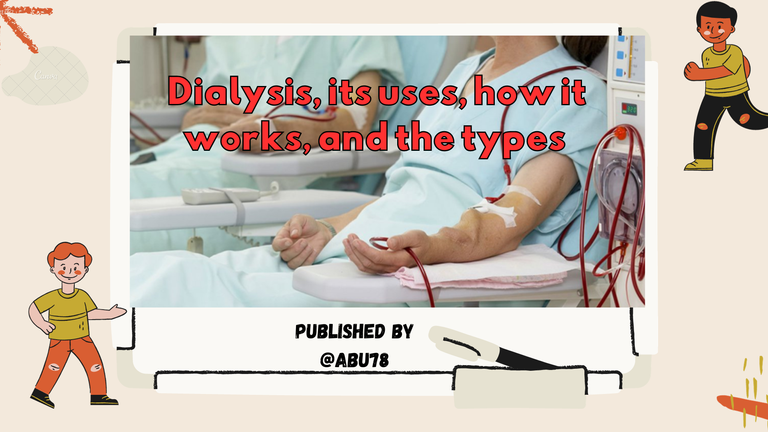Greetings to all and sundry on this great platform, I am really excited to be back after a long inactivity in this great community. I was really occupied with my academic activities as a final-year student. I had to learn harder and make good grades as I was about to graduate, with all things being equal, I have successfully completed my four-year study in Biochemistry now, and I am really grateful and thankful to God for such a blessing and favor. As you all know me to be a vibrant and active member of this great community, I am back again and I will try to be more active once again just like I used to be.

Without much I do, today, our topic of discussion will be about Dialysis, how dialysis works, the types of dialysis, and possibly the side effects as well. Stay tuned as I elaborate more on this topic in this article. First of all, let's look at what basically dialysis is referred to as.
Dialysis as we all know is a form of treatment that is given to kidney failure patients to help in the removal of extra fluids and waste products from the blood of the patient. It is provided or recommended when the kidney which is in charge of excreting or removing the waste products from blood fails to do so. In the 1940s, the first Dialysis was successfully used as a treatment for kidney failure, and since 1970's it has become a standard treatment for kidney failure as we can see in our various hospitals currently. Based on the medical condition of the patient, dialysis can be performed either at the hospital, at home, or at a dialysis center. Let's look at the uses of dialysis as it is not only for kidney failure.
Dialysis as I explained earlier is used for the excretion of fluid or waste products from the blood when there is a kidney failure. This occurs when the kidney can only function at about 10-15% of its role and that can be measured by the (eGFR) estimated glomerular filtration rate which is less than 15mL/min. At this stage, the kidneys require extra support or energy in order to continue their function or in order to perform the function of the kidney. It is also termed as the end-stage kidney disease (ESKD). We need to understand that, dialysis only helps to perform some of the functions of the kidney and it is not a permanent cure to kidney failure diseases. A person with end-stage kidney disease will need either a kidney transplant for survival or dialysis for the rest of his/her life.

In addition, acute kidney injury which is also termed as AKI can sometimes involve the use of dialysis for a short period until the kidney is back to normal functioning. For this disease, the kidney is said to have incurred damage and can perform its functions within a few days. Let's then move to how dialysis works.
So, as stated earlier in this article, dialysis is basically done to help perform some of the basic functions of the kidney so as to keep your body balanced in certain nutrients or activities. These include; helping in the regulation of blood pressure, the removal of waste and extra fluids in the body to avoid building up in the body, and safely keeping the levels of minerals present in the blood such as bicarbonate, potassium, calcium, and sodium. Before I conclude this article, let's look at the types of dialysis that are commonly used or done.
Basically, there are two types of dialysis that are performed and they are Peritoneal dialysis (PD) and Hemodialysis (HD). Let's briefly look at them in this article. With Peritoneal dialysis, the infiltration of your blood is done within the patient's body instead of the usage of a dialyzer machine.

The peritoneum serves as a filter in this type of dialysis. Also, a minor surgery is done here in order to insert the soft tube (catheter) in the patient's stomach and the patient's stomach will be filled with dialysate at each treatment through the catheter that was inserted. This treatment can be done anywhere once the necessary equipment is available and not necessary it be in the hospital. There are two common types of peritoneal dialysis and they are Automated Peritoneal Dialysis (APD) and Continuous Ambulatory Peritoneal Dialysis (CAPD).
With Hemodialysis, it involves the usage of a dialyzer machine unlike the former which doesn't need it. This dialyzer machine serves as the filtering machine that removes the waste and extra fluid from the blood of the patient after which the filtered blood is returned into the body. Similarly, in hemodialysis, minor surgery is done to create a vascular access site in the arm of the patient for easy passage of blood from the body through the dialyzer and then back to the patient's body after filtration is done. Unlike Peritoneal dialysis, hemodialysis can either be done at home or at the dialysis center. This treatment is done thrice a week and it lasts about four hours a day.
We need to understand the fact that dialysis is very costly and expensive to solely depend on for the treatment of kidney failures and as a matter of that, it is highly recommended that we safely keep our kidneys well in order to prevent such huge costs. I will write in my next article about kidney diseases and how to keep our kidneys safe, so stay tuned to my blog for the next post.
Thank you all for your time and attention to reading my post. I am looking forward to seeing you all in my subsequent posts.

Thanks for your contribution to the STEMsocial community. Feel free to join us on discord to get to know the rest of us!
Please consider delegating to the @stemsocial account (85% of the curation rewards are returned).
Thanks for including @stemsocial as a beneficiary, which gives you stronger support.
I wish you success in your endeavor.
I'd sure be waiting to read more from you.